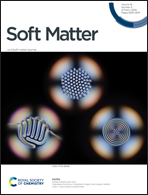Stretching and breaking of PEO nanofibres. A classical force field and ab initio simulation study
Abstract
The burgeoning development of nanotechnology is allowing us to construct more and more nano-scale systems in the real world that used to only exist in computer simulations. Among them, nanofibres made of only a few aligned polymeric chains in particular might soon have important roles in nanofabrications as well as in nanomedicine. In this work, we present a broad exploration by computer simulations of elastic and inelastic properties of polyethylene-oxide (PEO) nanofibres under load. We cover the full range from unloaded fibres up to their breaking point, focusing on all features that arise from chain–chain interactions and collective behaviour of the chains. We employ both molecular dynamics (MD) simulations and density functional theory (DF). The classical force field is represented by a minimal reactive force field model, allowing for the breaking of covalent bonds. Density functional (DF) computations provide a benchmark to gauge and validate the empirical force field approach, and offer an intriguing view of the bundle chemical evolution after breaking. Force-field based MD is employed for the systematic investigation of bundles of up to 24 chains, and for a single bundle of 100 chains. Low-temperature results for bundles under moderate loading provide a size-dependent sequence of cross-sections, structures, cohesive energies and elastic properties. A remarkably high Young's modulus on the order of 100 GPa was estimated with DF and MD, explained by the semi-crystalline state of the fibres giving mechanical properties comparable to those of carbon nanotubes and of graphene. Breaking is investigated by simulations with constant strain rate or constant stress. The bundle breaks whenever the potential energy is raised above its metastability range, but also below that limit due to creep activated by thermal fluctuations. A Kramer's-type approximation for the rate of chain breaking is proposed and compared to simulation data.



 Please wait while we load your content...
Please wait while we load your content...